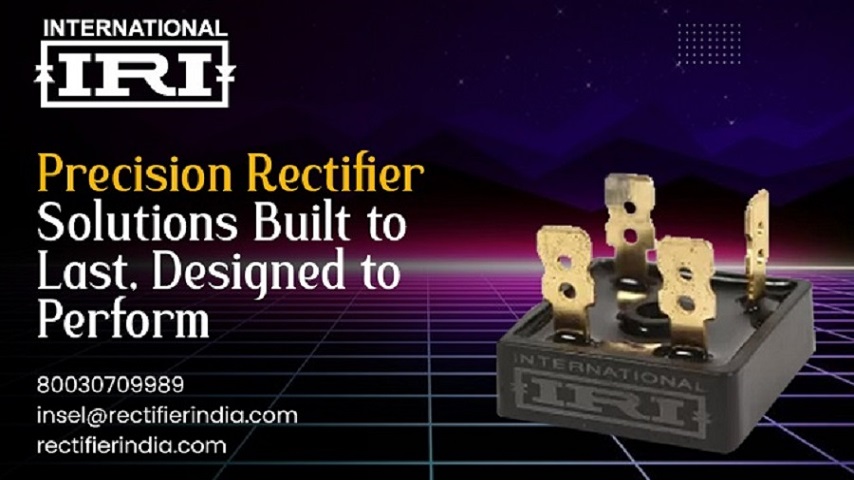Rectifiers are essential for delivering steady and dependable performance in a variety of electrical applications, from power supply conversion from AC to DC to smooth current flow in diverse devices. A system’s performance can be greatly impacted by the selection of rectifier, be it a half wave bridge rectifier or a full wave bridge rectifier. Performance, longevity, and overall efficiency can all be improved by picking the best bridge rectifier manufacturer and realizing the significance of these parts.
Understanding Bridge Rectifiers
An electrical component called a bridge rectifier is used to change alternating current (AC) into direct current (DC). Rectification is a crucial step in power supplies since DC is necessary for the efficient operation of many systems and devices. The negative cycle of the AC waveform is removed and converted into a useful DC output by a bridge rectifier, which is made up of diodes organized in a bridge design to allow current to flow in a single direction.
Bridge rectifiers are essential in many different applications, ranging from massive industrial machinery to modest domestic electronics. Whether you require uninterrupted power for industrial-grade systems or household appliances, the correct bridge rectifier guarantees that energy is effectively converted and provided to devices.
Full Wave Bridge Rectifier: Superior Performance and Efficiency
Full-wave bridge rectifiers are among the most widely used and effective rectification techniques. The rectification of both sides of the AC waveform is made possible by the bridge arrangement of four diodes that it utilizes. Consequently, it generates a smoother and more efficient continuous DC output compared to half-wave rectification.
One of the primary advantages of a full wave bridge rectifier is that it utilizes both positive and negative cycles of the AC input, effectively doubling the output frequency. This results in less ripple and a more stable DC signal, which is ideal for applications that require consistent power, such as power supplies for sensitive electronics, medical devices, and communication equipment.
Furthermore, the efficiency of a full wave rectifier is significantly higher than its half wave counterpart. Because it uses both halves of the AC cycle, it delivers more power while minimizing energy loss. This makes the full wave bridge rectifier the preferred choice for applications where efficiency and reliability are paramount.
Half Wave Bridge Rectifier: Cost-Effective Simplicity
In certain applications, the half wave bridge rectifier is a more straightforward and economical option, even though the full wave bridge rectifier provides better performance. A half wave rectifier essentially cuts the output in half by rectifying the positive half of the AC waveform using just one diode. The DC output from this technique pulses, making it less smooth than what a full wave rectifier would provide.
The half wave bridge rectifier’s main benefits are its affordability and ease of use. Because it uses fewer components, it is simpler to design and install in circuits where space and money are constraints or when there is no requirement for DC conversion. It performs well in low-power applications such as small battery chargers or power supplies for basic electronics, while being less efficient than a full wave rectifier.
However, the main downside is the increased ripple in the output. Since the half wave rectifier only rectifies half of the input signal, the resulting DC output has a larger variation, which can lead to less stable performance in sensitive equipment. Despite these limitations, half wave bridge rectifiers are still widely used in simple or low-cost applications where efficiency and output stability are less critical.
Choosing the Right Bridge Rectifier Manufacturer
Making the proper bridge rectifier manufacturer choice is essential to guaranteeing the dependability and durability of your rectification system. The caliber of the diodes, the accuracy of the design, and the entire manufacturing process all affect a rectifier’s performance. Reputable manufacturers make sure all of their components are constructed in accordance with industry standards and offer durable performance, even in the most demanding situations.
A trustworthy supplier of bridge rectifiers provides more than just superior goods. They offer assistance and knowledge to help you select the ideal rectifier for your particular requirements. Whether you need a half wave bridge rectifier for simpler jobs or a full wave bridge rectifier for high-power applications, a reliable manufacturer makes sure the rectifiers are built to last and function well in a variety of situations.
When looking for a bridge rectifier manufacturer, consider their experience in the industry, the range of products they offer, and their reputation for delivering durable and efficient components. Manufacturers that invest in research and development often provide more advanced solutions, ensuring that their rectifiers are at the cutting edge of technology. This leads to better performance, energy efficiency, and reliability in the long term.
Conclusion
To sum up, rectification is an essential step in contemporary power systems and electronics. Knowing your needs and choosing the best rectification solution are crucial, regardless of whether you require the full-wave bridge rectifier’s better performance or the half-wave rectifier’s affordable simplicity. Working with a trustworthy bridge rectifier manufacturer also guarantees that your rectifiers are made to last and are intended to function, offering long-term dependability and effectiveness for any application.









